Services on Demand
Journal
Article
Indicators
-
 Cited by SciELO
Cited by SciELO -
 Access statistics
Access statistics
Related links
-
 Cited by Google
Cited by Google -
 Similars in
SciELO
Similars in
SciELO -
 Similars in Google
Similars in Google
Share
Agronomía Colombiana
Print version ISSN 0120-9965
Agron. colomb. vol.33 no.2 Bogotá May/Aug. 2015
https://doi.org/10.15446/agron.colomb.v33n2.52000
Doi: 10.15446/agron.colomb.v33n2.52000
1 Faculty of Basic and Applied Sciences, Agrobiology Research Group, Universidad Militar Nueva Granada, Cajicá (Colombia). carlmgrijalba@gmail.com, agrobiologia@unimilitar.edu.co
Received for publication: 10 April, 2015. Accepted for publication: 30 June, 2015.
Abstract
In Colombia, high-tunnel systems may be a viable alternative for increasing the yields of strawberry crops due to their ability to prevent fruit losses and plant damage caused during periods of high precipitation. This study aimed to compare the yield and its relationship with vegetative and reproductive components of Albion and Monterey strawberry cultivars, established in open-field and high-tunnel systems in Cajica (Colombia), at 2,562 m a.s.l. and 4°56'N, 74°00'W. A combined analysis of the environments was carried out. A random complete block design was used in each environment with six replications for each cultivar. This study evaluated the relationship between the leaf area, the number of crowns, the number of leaflets, the number of flowers, the number of inflorescences, the number of flowers per inflorescence, the number of fruits, the incidence of foliar damage, the yield per plant and the fruit size. There were positive correlations between the vegetative variables and the reproductive variables, which explained why 'Monterey', a cultivar with more vigor, presented a higher yield that 'Albion'. The growth conditions in the high-tunnel system promoted rapid vegetative growth in the 'Monterey' plants, with an increase in yield and a decrease in losses. The 'Albion' cultivar plants in the high-tunnel system presented a decrease in fruit losses; however, these plants did not present differences in the yield, as compared to the plants established in the open-filed system. Despite the benefits of a decrease in fruit losses due to rot seen in the high-tunnel system, this system had an increase in powdery mildew and calcium deficiency.
Keywords: Fragaria x ananassa, 'Monterey', 'Albion', high tropics, crop protection, plant health.
Resumen
En Colombia, los macrotúneles pueden ser una alternativa viable para aumentar los rendimientos en el cultivo de fresa debido a su capacidad para prevenir pérdidas de fruta y daños en las plantas ocasionados en las épocas de altas precipitaciones. El objetivo del estudio fue comparar el rendimiento y su relación con componentes vegetativos y reproductivos, de los cultivares de fresa Albion y Monterey establecidos en condiciones de campo abierto y bajo macrotúnel, en Cajicá (Colombia), 2.562 msnm y 4°56'N, 74°00'O. Se realizó un análisis combinado de los ambientes. En cada ambiente se trabajó un diseño de bloques completos al azar con seis repeticiones para cada cultivar. Se evaluaron las relaciones entre el área foliar, el número de coronas, de foliolos, de flores, de inflorescencias, de flores por inflorescencia, de frutos, la incidencia de daños foliares, el rendimiento por planta y el tamaño del fruto. Se presentaron correlaciones positivas entre las variables vegetativas con las reproductivas, lo que explica porque 'Monterey', un cultivar con mayor vigor, presentó un mayor rendimiento que las plantas del cultivar 'Albion'. Las condiciones de crecimiento en el macrotúnel promovieron un rápido crecimiento vegetativo en las plantas de 'Monterey' con un aumento en los rendimientos y disminución en las pérdidas. Las plantas del cultivar 'Albion' bajo macrotúnel presentaron una disminución en las pérdidas de fruta, sin embargo, no presentaron diferencias de rendimiento en comparación a las establecidas en campo abierto. A pesar de los beneficios que trae el macrotúnel en la disminución de pérdidas de la fruta a causa de pudriciones, se presentó un aumento en la incidencia de mildeo polvoso y la deficiencia de calcio.
Palabras clave: Fragaria x ananassa, 'Monterey', 'Albion', trópico alto, protección de cultivos, fitosanidad.
Introduction
The strawberry (Fragaria x ananassa) is considered the most economically important berry worldwide (Hummer and Hancock, 2009). Its fruit is highly appreciated due to its organoleptic properties and phytochemical content (Halvorsen et al., 2006). In Colombia, the cultivated area for strawberries drastically increased between 2000 and 2009, from 629 ha to 1,306 ha, and, starting this year, the cultivated area has remained constant, with yields between 30 and 40 t ha-1 yr-1 (Agronet, 2014). In Colombia, good yields are possible thanks to year-round production, with harvest peaks that occur approximately every 3 or 4 months, as has been reported for other high tropical zones of South America, such as Ecuador (Hancock, 1999; Kirschbaum and Hancock, 2000).
One of the methods for increasing yields involves the use of plastic covers, which are designed to modify the environmental conditions in order to prolong the harvest period, increase early crops, increase yields, improve quality, reduce the mechanical damage caused by hail and/or strong rain, and reduce the incidence of phytopathogenic fungi, among others (Wittwer and Castilla, 1995; Jiang et al., 2003). One such method is the high-tunnel system, which, when compared to greenhouses, is low-cost and provides a viable alternative due to its favorable technical/economic optimization ratio (Ferrato et al., 2003; Lamont, 2009). High-tunnels are semi-permanent structures and, unlike some greenhouses, are not automated and do not use electrical systems for permanent heating or cooling, but instead use passive ventilation (Wells, 1996; Carey et al., 2009; Lamont, 2009).
The open-field system is the predominant strawberry production method in Colombia (Rubio et al., 2014); however, due to the high precipitation in the producing regions, high-tunnels could mitigate some phytosanitary problems by reducing the free water on the plants and fruits (Jensen and Malter, 1995; Lamont, 2009). The most common disease in this fruit is caused by the phytopathogen Botrytis cinerea and causes a significant decrease in yield (Ceredi et al., 2009). High-tunnels have the ability to decrease losses because they generate an environment that is less conducive for this phytopathogen, as reported by Xiao et al. (2001). This study aimed to evaluate the yield and its relationship with the vegetative and reproductive components of Albion and Monterey strawberry cultivars established under high-tunnel and open-field systems.
Materials and methods
This study was conducted in the municipality of Cajica (Cundinamarca, Colombia), in the experimental fields of the Universidad Militar Nueva Granada, located at 4°56'N, 74°00'W and 2,562 m a.s.l.
The vegetative material was composed of "frigo" strawberry plants of the Albion and Monterey cultivars, which were planted in September of 2012 in 6 beds (0.70 m wide, 0.40 m high, 13.5 m long), that were covered with black polyethylene mulch. Each bed had two rows of staggered plants with a distance between the rows of 0.3 m and between the plants of 0.3 m. In each crop environment (high-tunnel and open-field), closed fertigation circuit was used with two drip lines per bed and daily irrigation at a volume of 200 mL/plant. The No. 2 nutritive solution of Hoagland and Arnon (1950) was used for the fertigation, as cited by Cadahía (2005), which was adjusted in accordance with the soil analysis.
This study used two environments: open-field and high-tunnel; each one had an area of 200 m2. Three high-tunnels were installed (2.7 m high, 4.0 m wide, 18.0 m long). Taking into account the low seasonal temperature fluctuation seen in high tropical zones coupled with a big variation in temperature throughout the day, the design of the high-tunnels used in this study employed passive ventilation to avoid temperatures over 28°C, which have been reported to negatively affect flowering and yields in this crop (Hancock, 1999; Chen, 2013).
A randomized complete block design was used in each crop environment with six replications for the two treatments, which corresponded to the Albion cultivar and the Monterey cultivar. Each block had 30 plants, from which 10 uniform plants in full competition were selected for the respective response variable monitoring. The monitoring of the air temperature, relative humidity, and precipitation was carried out in each environment with meteorological stations, registering the information hourly.
The leaf area was determined per plant with a nondestructive method using a previously adjusted model that estimated the leaf area from the length of the leaflets with the equation Y = 0.8316X1.0784 (R2=0.956), where Y is the area of the leaflet (cm2) and X is the length of the leaflet (cm). The variables of leaf area, number of crowns (stems), number of leaflets, number of flowers, number of inflorescences and number of flowers per inflorescence, were evaluated per plant during 10 samplings that were distributed over 202 das (days after sowing).
All of the leaves of each plant were inspected to determine the number of leaves affected by biotic or abiotic factors. Afterwards, using this information, the damage incidence was determined from the percentage of affected leaves in relation to the total number of leaves per plant.
The yield was evaluated per plant during 54 weeks of harvesting. The fruit weight and diameter were evaluated with all of the harvested fruits per plant until 202 das.
In order to evaluate the relationship between the vegetative and reproductive components of the plants (including the yield), the data of the different variables were accumulated for each plant for 202 das, and Spearman correlations were applied with SAS® v.9.1.3 (SAS Institute, Cary, NC). With the same data, a principal components analysis was carried out with Statgraphics Centurion® XVI v.16.2.04 (StatPoint Technologies, Warrenton, VA). Furthermore, the yield results were subjected to a combined analysis of variance with SAS and the multiple comparisons were evaluated using the LSMEANS and DIFF commands of the PROC GLM procedure.
Results and discussion
The majority of the vegetative variables (leaf area, number of crowns, number of leaflets), were correlated with the reproductive variables (number of flowers, number of inflorescences, number of flowers per inflorescence), and with the yield (production and number of fruits), as can be seen in Figs. 1 and 2. The entire variable block, from the crowns to the inflorescences, presented highly significant correlations and, at the same time, the yield and number of fruits were highly dependent on the number of flowers and the number of inflorescences. The damage incidence in the strawberry leaves negatively affected the number of inflorescences and, therefore, the yield. The variable of flowers per inflorescence presented a positive relationship with some of the vegetative variables and yield; however, their correlation coefficients were low.
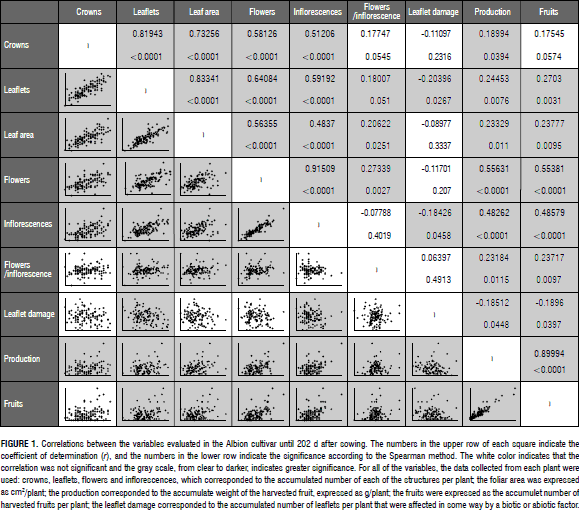
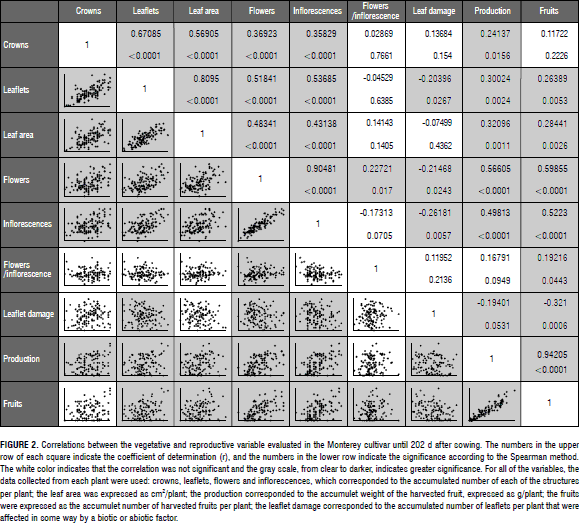
Using the principal components analysis, the results were summarized in the correlations and the relationship with new variables was added. The first principal component was weighted for the majority of the variables due to its correlation: number of crowns, number of leaflets, leaf area, number of inflorescences, number of flowers, yield, and number of fruits; while the second principal component gave a high value to the fruit diameter and individual weight (Fig. 3A). The leaf damage, as a harmful effect, presented negative values on the first principal component. The principal components analysis of the evaluated treatments showed that the highest values of the first principal component were seen in the high-tunnel environment with the Monterey cultivar, indicating that these plants presented a higher vegetative vigor and a higher yield, followed by the 'Monterey' plants found in the open-field system. For its part, the Albion cultivar, in the high-tunnel and open-filed environments, presented the lower values in the first principal component (Fig. 3B). There was a tendency for an increase in the second principal component in the treatments of the open-field environment, representing fruits with larger diameters and sizes (Fig. 3B). The individual fruit weight had a negative relationship with the variables of yield and number of fruits, which is reflected in the figure containing the principal component weight by being in opposing squares (Fig. 3A). This could have been caused by a low number of fruits with a high capacity for filling and photoassimilate capture due to lower sink competition, as compared to a plant with a lot of fruits (Taiz and Zeiger, 2010; Marschner, 2011).
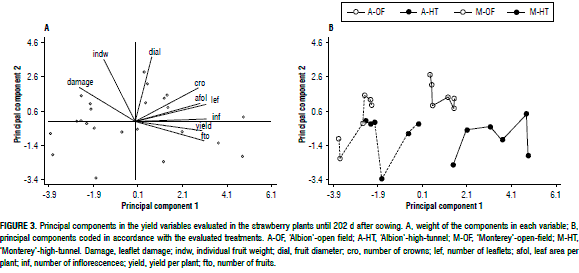
The vegetative component of strawberries and other species is important due to the fact that plants with a high vigor have the ability to produce more photoassimilates and, therefore, a higher ability to produce flowers and fruits (Albregts, 1968; Lacey, 1973; Cocco et al., 2011). Although there is competition for assimilates between the vegetative and reproductive components, adequate vegetative growth after transplanting must be ensured in order to have sustained yield (Shaw, 1993), which is vital in tropic conditions due to the year-round production that occurs there.
At the statistical level, the yield presented an interaction between the evaluated factors (Tab. 1) because the 'Monterey' had a higher production in the high-tunnel system, as compared to the open-field system (P≤0.05), while the 'Albion' did not have significant differences between the two environments.
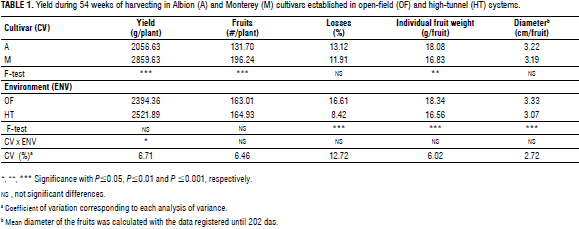
The production peaks of the 'Monterey' were higher than those of the 'Albion' (Fig. 1A-B), results that agree with the reports for these materials in their respective patents, which describe 'Monterey' as a cultivar with a higher vegetative vigor and yield than 'Albion' (Shaw and Larson, 2006; Shaw and Larson, 2009). In the 'Monterey', the production peaks were more evident and the two peaks that were registered over the course of the year were separated by approximately 5 months, a time period that differed from those reported by other authors who have stated that these peaks are seen every 3 months (Hancock, 1999; Kirschbaum and Hancock, 2000).
The high-tunnel environment produced a higher yield in the 'Monterey', as compared with the production obtained in the open-field system, principally due to a reduction in losses (Tab. 1; Fig. 4B). The losses increased in the rainy seasons (Fig. 5), and mainly resulted from rot caused by the phytopathogen Botrytis cinerea. This beneficiary effect generated by high-tunnels has been reported in different locations around the world (Xiao et al., 2001; Kadir et al., 2006; Carey et al., 2009; Lamont, 2009).
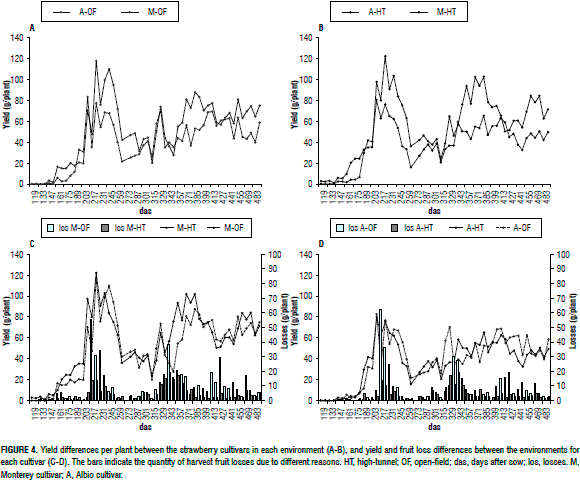
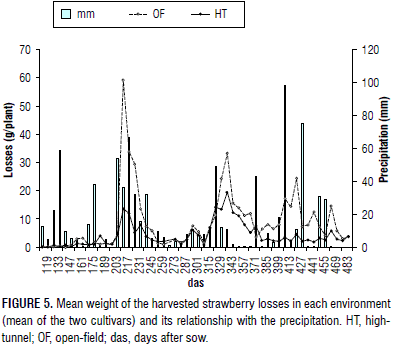
There was also a reduction in losses for the 'Albion' in the high-tunnel system; however, the yield was similar to the yield seen in the open-field system. This result, along with a smaller fruit size (Tab. 1), indicated the disadvantages that can be seen in high-tunnel conditions. The possible causes for this negative effect seen in high-tunnels include the plant damaged caused by the incidence of powdery mildew and deficiency of calcium. The latter results in leaf tip burning, a symptom that was higher in 'Albion', a cultivar catalogued as being susceptible to this problem (Krikke, 2011). The plants in the high-tunnel system had an increase in the incidence of this disorder due to the fact that their rapid growth, which has also been reported as a cause for increasing this problem, results in a higher demand for nutrients and a misbalance between the aerial and radicular parts (Saure, 1998; Palencia et al., 2010). The increase in the air temperature, the decrease in the relative humidity in the high-tunnel (Fig. 6), and the fluctuation of these factors during the day also contributed to the presence of the symptoms of calcium deficiency, causing a higher stomatal closure, which affects the transport of this nutrient to new leaves (Krikke, 2011), more so if the fact that its transport is mainly via the xylem in the transpiration process is taken into account (Taiz and Zeiger, 2010; Marschner, 2011).
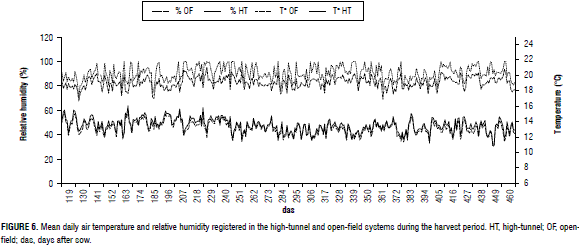
Among the symptoms of calcium deficiency, a reduction in fruit size is also seen (Nestby et al., 2005), which, together with an increase in stomatal closure resulting from a water deficit, can decrease yield due to the fact that the water needed to optimize fruit filling is not provided (Grant et al., 2012).
According to the analysis of the soils, the high-tunnel system presented a texture with more clay (45% clay, 35% loam and 20% sand), as compared with the texture of the open-field system (30% clay, 50% loam, and 20% sand). Clay soils reduce evaporation and transpiration due to a chemical interaction with water (Bellingham, 2014) and, in general, present a higher capacity for moisture retention. Nonetheless, the increase in the air temperature and the decrease in the relative humidity that were seen in the high-tunnel system may have promoted a water deficit in the strawberry plants despite irrigation applications that were similar in the two environments, which could explain the increase in the problems of calcium deficiency and fruit filling.
Conclusions
The yield of the strawberry plants presented positive correlations with all of the vegetative and reproductive variables, except for the individual weight of the fruits, which presented a negative relationship.
'Monterey' presented a higher yield than 'Albion' due to a higher vegetative vigor represented in all of the evaluated variables, as well as a high number of reproductive structures.
The technology of the high-tunnel system has the potential to increase yield through a reduction of losses and of damage mainly caused by precipitation; however, a preventative control of disease such as powdery mildew, a differential management in the fertigation and the selection of cultivars that are suitable for this environment are necessary, as seen in the case of 'Monterey'.
Acknowledgments
The authors thank the Universidad Militar Nueva Granada for financing this study through the research projects CIAS 938 and CIAS 1179, and Proplantas S.A., CVR and Colpozos S.A. for their support.
Literature cited
Agronet. 2014. Producción de fresa en Colombia, 2000-2013. www.agronet.gov.co/agronetweb1/; consulted: May, 2015. [ Links ]
Albregts, E.E. 1968. Influence of plant size at transplanting on strawberry fruit yield. Proc. Fla State Hort. Soc. 81, 163-167. [ Links ]
Bellingham, B.K. 2014. Foreward. pp. XXVII-XXXI. In: Goyal, M.R and E.W. Harmsen (eds.). Evapotranspiration: principles and applications for water management. Apple Academic Press, Oakville, Canada. [ Links ]
Cadahía L., C. 2005. Cultivo de fresón. pp. 411-427. In: Cadahía L., C. (ed.). Fertirrigación de cultivos hortícolas, frutales y ornamentales. 3rd ed. Editorial Mundi-Prensa, Madrid. [ Links ]
Carey, E.E., L. Jett, W.J. Lamont Jr., T.T. Nennich, M.D. Orzolek, and K.A. Williams. 2009. Horticultural crop production in high tunnels in the United States: a snapshot. HortTechnology 19, 37-43. [ Links ]
Ceredi, G., L. Antoniacci, C. Montuschi, E. De Paoli, M. Mari, and S. Gengotti. 2009. Ten years of field trials on grey mold control on strawberries. Acta Hortic. 842, 327-330. [ Links ]
Chen, D. 2013. The effect of heat on fruit size of day-neutral strawberries. Master of Science Thesis In Plant Agriculture. University of Guelph, Guelph, Canada. [ Links ]
Cocco, C., J.L. Andriolo, F.L. Cardoso, L. Erpen, and O.J. Schmitt. 2011. Crown size and transplant type on the strawberry yield. Sci. Agric. 68, 489-493. Doi: 10.1590/S0103-90162011000400015 [ Links ]
Ferrato, J., A. Muguiro, F. Tineo, R. Grasso, A. Longo, M.C. Mondino, L. Carrancio, and V. Duarte. 2003. Experiencias sobre nuevas tecnologías hortícolas en cultivos bajo cubierta. Ministerio de Educación, Ciencias y Tecnología; Instituto Nacional de Educación Tecnológica, Buenos Aires. [ Links ]
Grant, O.M., M.J. Davies, A.W. Johnson, and D.W. Simpson. 2012. Physiological and growth responses to water deficits in cultivated strawberry (Fragaria × ananassa) and in one of its progenitors, Fragaria chiloensis. Environ. Exp. Bot. 83, 23-32. Doi: 10.1016/j.envexpbot.2012.04.004 [ Links ]
Halvorsen, B.L., M.H. Carlsen, K.M. Phillips, S.K. Bøhn, K. Holte, D.R. Jacobs Jr, and R. Blomhoff. 2006. Content of redox-active compounds (ie, antioxidants) in foods consumed in the United States. Am. J. Clin. Nutr. 84, 95-135. [ Links ]
Hancock, J.F. 1999. Strawberries. Crop Production Science in Horticulture. Vol. 11. CABI Publishing, Oxon, UK. [ Links ]
Hummer, K.E. and J. Hancock. 2009. Strawberry genomics: botanical history, cultivation, traditional breeding and new technologies. pp. 413-435. In: Folta, K.M. and S.E. Gardiner (eds.). Genetics and genomics of Rosaceae. Vol. 7. Springer, New York. Doi: 10.1007/978-0-387-77491-6_20 [ Links ]
Jensen, M.H. and A.J. Malter. 1995. Protected agriculture: a global review. Technical Papel No. 253. World Bank, Washington DC. [ Links ]
Jiang, W.J., D.Y. Qu, D. Mu, and L.R. Wang. 2003. Protected cultivation of horticultural crops in China. Hortic. Rev. 30, 115-162. Doi: 10.1002/9780470650837.ch4 [ Links ]
Kadir, S., E. Carey, and S. Ennahli. 2006. Influence of high tunnel and field conditions on strawberry growth and development. HortScience 41, 329-335. [ Links ]
Kirschbaum, D.S. and J.F. Hancock. 2000. The strawberry industry in south america. HortScience 35, 807-811. [ Links ]
Krikke, R. 2011. News letter tip burn strawberry. Relab den Haan. Texel, The Netherlands. [ Links ]
Lacey, C.N.D. 1973. Phenotypic correlations between vegetative characters and yield components in strawberry. Euphytica 22, 546-554. Doi: 10.1007/BF00036655 [ Links ]
Lamont Jr., W.J. 2009. Overview of the use of high tunnels worldwide. HortTechnology 19, 25-29. [ Links ]
Marschner, P. (ed.). 2012. Marschner's mineral nutrition of higher plants. 3rd ed. Academic Press, London. [ Links ]
Nestby, R., F. Lieten, D. Pivot, C.R. Lacroix, and M. Tagliavini. 2005. Influence of mineral nutrients on strawberry fruit quality and their accumulation in plant organs. Int. J. Fruit Sci. 5, 139-156. Doi: 10.1300/J492v05n01_13 [ Links ]
Palencia, P., F. Martinez, E. Ribeiro, M. Pestana, F. Gama, T. Saavedra, A. de Varennes, and P.J. Correia. 2010. Relationship between tipburn and leaf mineral composition in strawberry. Sci. Hortic. 126, 242-246. Doi: 10.1016/j.scienta.2010.07.024 [ Links ]
Rubio, S.A., A.M. Alfonso, C.M. Grijalba, and M.M. Pérez.2014. Determinación de los costos de producción de la fresa cultivada a campo abierto y bajo macrotúnel. Rev. Colomb. Cienc. Hortic. 8, 67-79. Doi: 10.17584/rcch.2014v8i1.2801 [ Links ]
Saure, M.C. 1998. Causes of the tipburn disorder in leaves of vegetables. Sci. Hortic. 76, 131-147. Doi: 10.1016/S0304-4238(98)00153-8 [ Links ]
Shaw, D.V. 1993. Genetic correlations between vegetative growth traits and productivity at different within-season intervals for strawberries (Fragaria x ananassa).Theor. Appl. Genet. 85, 1001-1009. Doi: 10.1007/BF00215040 [ Links ]
Shaw, D.V. and K.D. Larson. 2006. Strawberry plant named "Albion". Patent US PP16228 P3. The Regents of The University of California, Oakland, CA. [ Links ]
Shaw, D.V. and K.D. Larson. 2009. Strawberry plant named "Monterey". Patent US PP19767 P2. The Regents of The University of California, Oakland, CA. [ Links ]
Taiz, L. and E. Zeiger. 2010. Plant physiology. 5th ed. Sinauer Associates, Sunderland, MA. [ Links ]
Wells, O.S. 1996. Rowcover and high tunnel growing systems in the United States. HortTechnol. 6, 172-176. [ Links ]
Wittwer, S.H. and N. Castilla. 1995. Protected cultivation of horticultural crops worldwide. HortTechnol. 5, 6-23. [ Links ]
Xiao, C.L., C.K. Chandler, J.F. Price, J.R. Duval, J.C. Mertely, and D.E. Legard. 2001. Comparison of epidemics of botrytis fruit rot and powdery mildew of strawberry in large plastic tunnel and field production systems. Plant Disease 85, 901-909. Doi: 10.1094/PDIS.2001.85.8.901 [ Links ]














